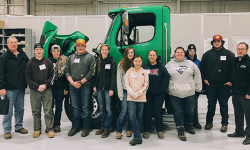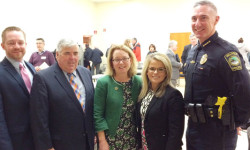[ccfic caption-text format="plaintext"]
By James Kinneen
Hometown Weekly Reporter
Most teachers will tell you that when a kid comes back from summer break, all too often they will say that they both did and learned “nothing.” And even among those kids who found summer jobs, it’s hard to imagine that they learned a wide variety of life skills doing classic teenage labor like scooping ice cream or caddying at a golf course.
Norfolk County Agricultural High School has solved both of these issues for 29 of its students.
Because of a $160,000 grant from the Massachusetts Clean Energy Center, through their Learn and Earn Program, 29 Norfolk Aggie students are making twelve dollars an hour while working, essentially as a small business, to create thirty instructional carts to teach schoolchildren about clean energy.
Essentially, the carts are easily-transportable, but fully-functional energy producing devices that will show kids how solar panels and wind turbines can create energy. There are three different types of carts (the thirty will consist of ten of each type), designed to show off three different clean energy functions.
First, there is a solar panel with USB outlets so kids can use the energy created to charge their phones. Next, there is a solar thermal cart that will heat water held in a bucket below. And, finally there is a wind turbine that will spin and create energy (the idea being that the kids will be attracted to the element of real, moving parts). There will also be a three-day teacher training class focused on climate change and clean energy technology.
Perhaps the most impressive aspect of the project is how well it’s functioned. While the students did get to go on a couple field trips to places like Block Island and Hull (to see how they were generating power from clean sources, like wind), inside the school, every student has been doing something - from dealing with the accounting and payment to chronicling the project via photography or 3D-printing a part. The project has made the Aggie look like a legitimate clean-energy business.
But, if you think that having to work so hard (and actually produce a usable product) had the kids dreaming of being a lifeguard at the beach or some other teen job they make zany movies about, you’d be wrong. All the kids seemed to express gratitude for the program.
“It’s a great opportunity for a teenager,” said Aidan McDonagh. “It’s a good thing that we’re doing and we get a little bit of money, so it’s a great deal.”
“I learned a lot this summer,” added John Green. “Way more than I would have doing another job I could get at 16.”
Lest we forget who else gets the summer off, the three environmental science teachers involved also noted how much they’ve enjoyed the program. John Lee noted their futures will largely depend on finding a source of clean energy, declaring: “This is a great program for high school kids to learn about renewable energy and climate change. It’s an important part of their future and they get to earn and learn at the same time, so it’s a very beneficial program for both the school and the kids.”
“I’m just grateful to the Massachusetts Clean Energy Center for funding this project,” added Peter Kane. “It’s been a really good opportunity for the kids; they’re really learning a lot of good, practical hands-on skills, and a lot about clean energy. It wouldn’t have been possible without the grant we got from Mass Clean Energy.”

























